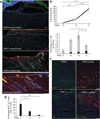Fgf9 from dermal γδ T cells induces hair follicle neogenesis after wounding
- PMID: 23727932
- PMCID: PMC4054871
- DOI: 10.1038/nm.3181
Fgf9 from dermal γδ T cells induces hair follicle neogenesis after wounding
Abstract
Understanding molecular mechanisms for regeneration of hair follicles provides new opportunities for developing treatments for hair loss and other skin disorders. Here we show that fibroblast growth factor 9 (Fgf9), initially secreted by γδ T cells, modulates hair follicle regeneration after wounding the skin of adult mice. Reducing Fgf9 expression decreases this wound-induced hair neogenesis (WIHN). Conversely, overexpression of Fgf9 results in a two- to threefold increase in the number of neogenic hair follicles. We found that Fgf9 from γδ T cells triggers Wnt expression and subsequent Wnt activation in wound fibroblasts. Through a unique feedback mechanism, activated fibroblasts then express Fgf9, thus amplifying Wnt activity throughout the wound dermis during a crucial phase of skin regeneration. Notably, humans lack a robust population of resident dermal γδ T cells, potentially explaining their inability to regenerate hair after wounding. These findings highlight the essential relationship between the immune system and tissue regeneration. The importance of Fgf9 in hair follicle regeneration suggests that it could be used therapeutically in humans.
Figures






References
-
- Ito M, et al. Wnt-dependent de novo hair follicle regeneration in adult mouse skin after wounding. Nature. 2007;447:316–320. - PubMed
-
- Breedis C. Regeneration of hair follicles and sebaceous glands from the epithelium of scars in the rabbit. Cancer Res. 1954;14:575–579. - PubMed
-
- Gurtner GC, Werner S, Barrandon Y, Longaker MT. Wound repair and regeneration. Nature. 2008;453:314–321. - PubMed
-
- Jameson J, et al. A role for skin γδ T cells in wound repair. Science. 2002;296:747–749. - PubMed
-
- Sharp LL, Jameson JM, Cauvi G, Havran WL. Dendritic epidermal T cells regulate skin homeostasis through local production of insulin-like growth factor 1. Nat. Immunol. 2005;6:73–79. - PubMed
Publication types
MeSH terms
Substances
Grants and funding
LinkOut - more resources
Full Text Sources
Other Literature Sources
Molecular Biology Databases

